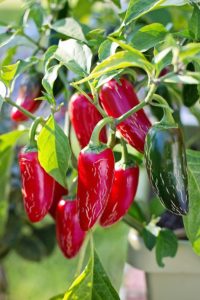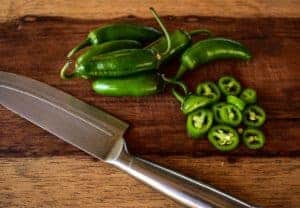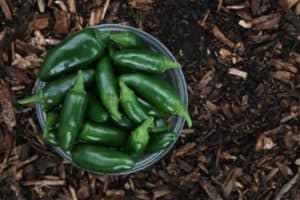 If you have limited space, like a balcony, or you want to grow indoors, or you just want to grow some vegetables on a patio or deck, growing jalapenos in pots is an excellent choice. Jalapenos are versatile peppers, kind of a jack-of-all-trades, great in salads, salsas, sauces, stuffed, pickled, or eaten fresh. Peppers in general are ideal vegetables to grow in pots.
If you have limited space, like a balcony, or you want to grow indoors, or you just want to grow some vegetables on a patio or deck, growing jalapenos in pots is an excellent choice. Jalapenos are versatile peppers, kind of a jack-of-all-trades, great in salads, salsas, sauces, stuffed, pickled, or eaten fresh. Peppers in general are ideal vegetables to grow in pots.
Jalapenos are well-suited for container gardening, and ideally should be grown in 5-gallon (19-L) pots or buckets for full-sized plants and better yield, but 2 gallons (7.5 L) is adequate. Ensure that the pot is filled with well-draining potting mix and has drainage holes at the bottom. One of the benefits of growing jalapenos in pots is that they can be moved to different locations, such as a sunny or shady spot, or somewhere safe from hazardous weather. Jalapenos grow best in full sun, but can benefit from growing in partial shade in very hot summer climates. If you live in an apartment, a south-facing balcony is best. Jalapenos can also be grown indoors in pots, but a grow light is necessary for optimal growth and flowering. Another advantage of growing jalapeno peppers in containers is that they can be overwintered easily, giving the plant a head start for the next spring.
On this page:
Pot Size for Jalapenos
Jalapenos flourish in containers, as long as the containers are large enough. To maximize yields, use a 5-gallon (19-L) pot or even a used 5-gallon food-grade bucket. If you go with something smaller, like a 2-gallon pot, your plant won’t get as large and you will have fewer peppers overall, but it will still be healthy and produce peppers for you. Smaller containers also need more frequent watering.
Make sure the pot you use is filled with rich, well-draining potting mix and there are adequate drainage holes at the bottom of the pot. I always recommend potting mix (homemade or purchased) instead of just garden soil. If your soil is too sandy, your container will barely hold on to any water and dry out too fast. If your soil has more clay, it will settle and condense around the roots, and hold onto too much water, leading to root rot. Peppers don’t like being overwatered, but they really struggle if the roots can’t breathe at all.
Can You Grow Jalapenos from Store-Bought Peppers
 As I’ve discussed in my article on growing peppers from their seeds, jalapenos are unripe peppers, so they would not have many viable seeds. During the ripening process, the seeds are also developing and maturing. You can still try to plant a lot of them and see if any sprout.
As I’ve discussed in my article on growing peppers from their seeds, jalapenos are unripe peppers, so they would not have many viable seeds. During the ripening process, the seeds are also developing and maturing. You can still try to plant a lot of them and see if any sprout.
That said, if you find your jalapenos are starting to ripen–they often turn a little darker and then start turning red at the tips–you can leave them on your kitchen counter and then when they’ve ripened, you can take those seeds and plant them with a higher chance of success.
Light Requirements of Jalapenos
Growing Jalapenos in Pots Outdoors
Outdoors, jalapenos do best in full sun, but can thrive in partial shade. In fact, if your climate is extremely hot in the summer, you can put your jalapenos along an east-facing fence or wall where they’ll get all that gentle morning sun and get some shady relief from the afternoon heat. If you live in an apartment, a south-facing balcony is the best location to grow jalapenos, but you can see success with east-facing and west-facing balconies. North-facing balconies are shaded too much in the summer; you can still try growing jalapenos, but expect fewer fruits compared to your neighbors on the other side of the building.
Growing Jalapenos in Pots Indoors
Sunlight from a south-facing window might be enough to overwinter a jalapeno to take outside next year, but I highly recommend getting a grow light if you want to actually grow jalapenos indoors or enjoy some fresh overwintered jalapeno harvests.
“I recommend LEDs just because they are more affordable and use less electricity…”
More light (up to a point) will stimulate more buds and flowers, and therefore fruit. I’ve grown peppers under different kinds of grow lights, from fluorescents to LEDs, and I will say that for jalapenos, they do best under strong, full-spectrum LEDs. Fluorescent bulbs, including compact fluorescents (CFLs) are great for starting pepper seedlings, keeping your peppers alive when overwintering, and getting a few peppers all season long. In my experience, they tend to produce very few peppers under CFL grow lights, but your mileage may vary. Thai peppers, in contrast, give me decent yields under fluorescents.
You do not need an expensive grow light for jalapeno plants. I recommend LEDs just because they are more affordable and use less electricity than metal halide or other lights which are overkill. For one jalapeno plant, a cheap SANSI 36W LED grow light (priced around $40) is more than enough.
Regardless of what light you use, keep it at least 2-4 inches above the plant to avoid overheating and damaging the leaves, and run your lights for at least 10-18 hours a day.
When to Plant Jalapeno Peppers
Whether you’ve started them from seed or you’ve bought them at a nursery, your jalapenos should be transplanted outside when nighttime temperatures stop going below 50°F (10°C), as cold nights can stunt their growth.
If you’re planting jalapeno seeds, the time to sow depends on the size of your pot you’re starting them in. It’s usually recommended about 10 weeks before you transplant them (or 8 weeks before your last frost date), which is fine if you’re starting them in 3-inch (7.6-cm) pots or larger. If you only have those small seed-starting trays, you can start them 6-8 weeks before you transplant them.
How Long Does it Take to Grow Jalapenos
From the moment your jalapenos sprouts start popping up (which can be anywhere from a few days to a couple weeks after sowing) you can expect your first jalapeno pepper harvest in a little over 3 months. So, if you sowed them in early or mid March, you will have your first jalapeno peppers sometime in mid or late June.

Fertilizing Jalapenos in Pots
Jalapeno plants don’t need much fertilizer when overwintering and after their peppers are maturing on the plant, but they are heavy feeders during the main leaf growth phase and flowering/fruiting phase.
If you’re growing jalapenos in pots, even if you use new potting mix you’ve just purchased, it really only has enough fertilizer for a month or two of growth. Jalapenos will quickly deplete a container of nutrients before the end of the season, so feed regularly, every 7-14 days, with an all-purpose liquid fertilizer. If you want, switch to a “bloom” formula (look for fertilizers with lower N and higher PK values) in early summer to encourage flowering and fruiting. You can also use slow-release fertilizer and reapply according to its instructions. For slow-release fertilizers, I like to use Jobe’s tomato spikes since peppers have similar nutrient requirements as tomatoes.
I’ve already written about why I use Jobe’s tomato spikes for peppers in more detail.
Overwintering Jalapeno Pepper Plants
Pepper plants are actually perennials, but they are frost tender, so that’s why most people grow them like annuals. But if you live in a climate with cold winters, you can bring your jalapeno peppers inside and keep them alive until spring, and get a significant head start on the season with some early jalapeno peppers. And if you use a powerful enough grow light, your plants will produce jalapenos throughout the winter.
I follow these steps when overwintering my pepper plants:
1. Prune most of the branches off your pepper plant. It might pain you to do it, but peppers are one of the few vegetables that really benefit from pruning to rejuvenate them and promote more growth. This also means cutting off any peppers.
How far want to go is personal preference. You could technically prune it down to a stump (leave at least a few inches since new branches will grow out the “bumps” on the stem) but it’s better to leave at least a few branches so you have a bigger “scaffolding” for more growth. In the above video, you can see an example of how to overwinter your peppers, and he cuts off all the foliage, leaving a few bare branches.
2. Optional: Take your jalapeno out of its container and clean off the roots, and then transplant into a new pot. You can see this in the above video. It’s not necessary; you can just bring the plant indoors right after pruning. But the benefit of this is cleaning off any soil-borne pests that could hitch a ride into your home. The roots will also grow back over time, so don’t worry if some of the roots end up getting damaged.
3. Take your jalapeno indoors, water it thoroughly once, and keep it out of strong light for a few weeks. Your jalapeno is going to go under a lot of stress once it’s brought indoors, even if you don’t transplant it. You can keep it by the window or under a grow light, but don’t give it too much light at this stage. You can also give it a very, very light feeding of fertilizer if you want.
4. Keep an eye on your jalapeno plant and water only when the top 1-2 inches of soil is dry. Since there are few to no leaves left on your jalapeno plant, it’s taking up less water, so you shouldn’t water it very often at this stage.
5. When you notice new green growth coming out of the bumps (nodes) on the stem and branches, get it under a grow light and take care of it as usual over the winter. By this point, your jalapeno will be recovering and will start rapidly putting out new shoots and leaves over the next few weeks, so you should keep it under a grow light to keep the new branches from getting leggy. If your grow light is powerful enough, you may start seeing the first little buds after a month or so and then jalapenos ready to pick a month or two later.
6. In the spring, take your jalapeno plant back outside when the night temperatures stay above 50°F (10°C). Keep it in the shade for a few days or take it out on a cloudy day so it can harden off and adapt to sunlight again. If you want, you can also prune it back again to encourage new growth.
